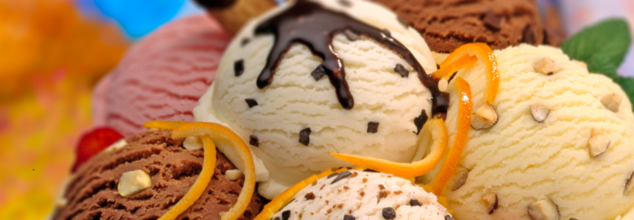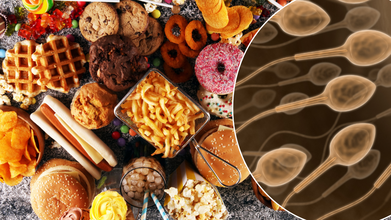- Health Conditions A-Z
- Health & Wellness
- Nutrition
- Fitness
- Health News
- Ayurveda
- Videos
- Medicine A-Z
- Parenting
- Web Stories
Plastic Pieces Prompt Recall Of Popular Ice Cream Brand

Credits: Canva
Ice cream is something we all can make a little room for after a heavy meal. However, they may not be the safest dessert for you. Nearly 18,000 containers of ice cream and frozen yogurt have been recalled by Iowa-based Wells Enterprise due to the potential presence of plastic pieces in the products.
The voluntary recall, made public through a recently released notice by the Food and Drug Administration (FDA), affects 22 flavors packaged in 3-gallon containers with "Best If Used By" dates ranging from March to October 2026.
The affected products belong to well-known brands such as Blue Bunny and Halo Top and were distributed nationwide. While no injuries have been reported yet, the recall serves as a cautionary reminder of how plastic contamination, even in small quantities, can pose health hazards.
The Invisible Threat of Plastic in Everyday Life
While this incident is related to visible pieces of plastic, a much more insidious threat lies in microplastics—tiny plastic particles smaller than five millimeters. These can make their way into the food chain, often without our knowledge.
Microplastics have been detected in everything from bottled water and sea salt to fruits, vegetables, and even human blood. One surprising source? Agriculture. A 2021 report by the United Nations Food and Agriculture Organization (FAO) revealed that agricultural soils may contain more microplastics than the oceans. This happens when plastic-coated seeds, pesticide containers, and mulch films degrade in the environment or when wastewater used as fertilizer brings in plastic particles.
Moreover, climate change has amplified farmers’ dependence on plastic tools such as tarps and greenhouse covers, which, under extreme heat or rain, break down faster and spread microplastics further into ecosystems.
Health Hazards: More Than Just an Environmental Concern
The risks of plastic exposure go far beyond environmental degradation—they extend directly to human health. For instance, microplastics have been found embedded in the fatty plaques of carotid arteries, which supply blood to the brain. A study presented at the American Heart Association’s conference revealed that these plaques contained over 50 times more microplastic content than healthy arteries. Individuals with higher concentrations were more likely to have suffered strokes or temporary vision loss due to restricted blood flow.
That’s not all. Regular use of plastic takeout containers may also contribute to cardiovascular diseases. A study published in Ecotoxicology and Environmental Safety found that thermal contact between hot food and plastic containers can cause chemicals to leach out. These chemicals not only disrupt gut bacteria but also inflame the circulatory system, increasing the risk of heart failure.
Everyday Exposure: Even Chewing Gum Isn’t Safe
Think you’re safe by avoiding packaged foods? Not entirely. A study presented at the American Chemical Society’s meeting found that chewing gum—whether synthetic or natural—can release around 100 microplastic particles per gram into saliva. These are then swallowed and enter the digestive system, where they may cause long-term harm.
Even 'Minimal' Portion Of Ultra-processed Foods Sabotage Male Fertility And Metabolism

Credits: iStock
Walk down any supermarket aisle, and it can feel like decoding a chemistry experiment just to buy dinner. "High-protein" cereal bars, "plant-based" ready meals, labels yell health, but many of them fall in the ultra-processed foods (UPFs) category. Recent studies show that even moderate intakes of these foods can play havoc with male reproductive systems and metabolic functions, raising serious questions about the unknown danger lurking in our contemporary diets.
In the last 50 years, obesity and type-2 diabetes prevalence have increased globally, whereas sperm quality has plummeted. This synchronous trend has led researchers to examine dietary drivers of these changes. Ultra-processed foods, containing high levels of refined carbohydrates, saturated fat, and additives, have been identified as a key culprit. In contrast to unprocessed foods, such foods are industrially processed, frequently low in fiber, and liable to impart concealed chemical contaminants, such as endocrine-disrupting chemicals.
"Even when eaten in moderation, ultra-processed foods are damaging to reproductive and metabolic health," explains Jessica Preston, lead author of a groundbreaking study at the University of Copenhagen's NNF Center for Basic Metabolic Research (CBMR). "It is not overeating them but their processed nature that makes them risky."
Why Same Calorie Consumption Have Different Consequences?
To understand the true impact of UPFs, researchers conducted a rigorous randomized controlled trial. Forty-three men, aged 20 to 35, participated in a crossover study comparing ultra-processed and minimally processed diets. Each diet was carefully matched for calories, protein, carbohydrates, and fats, and participants were unaware of which diet they were on.
The results were surprising, men added around 1 kilogram of fat mass on the ultra-processed diet, even when calorie consumption was similar. Cardiovascular indicators such as LDL cholesterol and diastolic blood pressure also deteriorated with UPF intake, emphasizing that these foods influence metabolism more than just calorie content.
Pollutants in Your Plate
UPFs not only are nutritionally poorer but also usually contaminated with chemical substances such as phthalates, which have a disrupting effect on hormones. The research established high concentrations of cxMINP, a metabolite of phthalates, among subjects eating ultra-processed foods. The substances associated with reduced testosterone and follicle-stimulating hormone, both important in the production of sperm.
Professor Romain Barrès, senior author of the study, underscores the broader implications, “We were shocked by how many body functions were disrupted, even in healthy young men. These results signal a need to revisit dietary guidelines to protect long-term reproductive and metabolic health.”
How is UPFs and Male Fertility Connected?
Dropping sperm counts are a worldwide concern, with research indicating around a 60% decline since the 1970s. Obesity and suboptimal dietary intake of fats play a role, but UPFs introduce a chemical element. The recent trial validated hormonal changes related to reproduction, such as reduced follicle-stimulating hormone (FSH) and trends toward reducing testosterone. Sperm motility also tended to decline, although change was not statistically significant in the short-term study.
These results are echoed in larger epidemiological studies correlating the consumption of UPFs with obesity, cardiovascular disease, diabetes, and even mental illness. The combination of chemical exposure, diets poor in nutrients, and metabolically disrupted metabolism makes UPFs especially pernicious.
How To Recognize Ultra-Processed Foods?
In spite of all this danger, UPFs own the shelves in supermarkets, camouflaged as health foods. Some telltale signs include:
Emulsifiers: Employed to mix ingredients together and produce creamy textures. Research indicates they can interfere with gut microbiota and the intestinal mucus barrier.
- Artificial sweeteners: Contained in low-calorie beverages and foods, these substances can quietly affect appetite and gut microbiota.
- Modified starches: Digested speedily and containing low amounts of fiber, they cause peaks in blood glucose with minimal nutrition.
- Protein isolates: Typical of shakes and meat alternatives, these isolate protein from its native environment and indicate intensive processing.
- Stabilizers and gums: Added to enhance texture, these are unknown in home kitchens and lead to gastrointestinal distress.
A useful rule is the "five-ingredient test": if you do not know five or more ingredients, it is probably ultra-processed. Or ask yourself whether you would normally stock these products in your pantry. Ingredients such as invert syrup, carboxymethylcellulose, and artificial flavorings are obvious warning signs.
How to Make Smarter Swaps To Make At The Grocery Store
Cutting UPF intake doesn't need drastic lifestyle adjustment. Minimally processed, simple alternatives can offer the same convenience without toxic additives:
- Packed legumes and fish: Canned beans, chickpeas, lentils, and plain fish are healthy and shelf-stable.
- Frozen vegetables and fruits: Often as nutrient-dense as fresh counterparts.
- Whole grains: Opt for plain brown rice or quinoa pouches in lieu of flavored instant packets.
- Additive-free sauces: Passata, tahini, pesto, and coconut milk present wholesome, ready-to-use meal bases.
Ultra-processed foods are not simply "empty calories." They are designed foods that disrupt metabolic well-being, hormonal balance, and reproductive health, even when consumed in moderate quantities. For males, the effects can be weight gain, changed cholesterol, and diminished fertility.
Although UPFs are not going away from world diets anytime in the near future, knowledge and wise food choices can help counteract them. Making whole and minimally processed foods a priority is not merely a plan for improved health, it is a protection for ongoing reproductive and metabolic health.
Weight Loss Diet Trend Linked To 135% Higher Risk Of Mortality: US Study Found Threat To Heart

(Credit-Canva)
Intermittent fasting is a very popular way of eating that focuses on when you eat, not necessarily what you eat. The most common method involves eating all of your food for the day within a short time frame, often an eight-hour window, and then not eating anything for the other 16 hours. People like it because it seems like an easy way to get healthier without having to count calories or cut out carbs.
However, is this healthy diet the reason for your declining health? Although it is said to be a good habit for your gut health and digestive health, could it slowly be chipping away at your heart health? A new study published in the Diabetes & Metabolic Syndrome: Clinical Research & Reviews looked into the same and found that it does more than slowly decline your health, it could also raise your mortality rate.
Is Intermittent Fasting Risky?
In the study, more than 19,000 adults has raised some serious concerns. It found that people who ate all their food in less than eight hours a day had a 135% higher risk of dying from heart and blood vessel disease than people who ate over a period of 12 to 14 hours.
This higher risk was found in all kinds of people, but it was strongest for smokers and people who already had health problems like diabetes or heart disease. While the study doesn't prove that intermittent fasting is the direct cause, it's a strong warning sign that it might not be a completely safe and easy way to get healthy.
Pros And Cons of Intermittent Fasting
Some smaller, short-term studies have shown that intermittent fasting can help you lose weight and improve your heart health. However, this new study brings a big concern to the table. An expert said that while this diet might help you lose weight and lower blood pressure, it can also lead to problems like not getting enough nutrients, feeling cranky, having headaches, and even losing muscle.
The main message from this research is that it's important to personalize your diet based on your own health. For now, experts say it's probably more important to focus on what you're eating rather than just when you're eating it. People with heart disease or diabetes should be especially careful about following a strict, short eating window for a long time.
How To Intermittent Fast Like A Pro: Beginner’s Guide
Intermittent fasting can be hard to follow, and it's not recommended for certain people, including those with advanced diabetes, pregnant women, and anyone who has had an eating disorder. Before you start, you should talk to your doctor to make sure it's a safe option for you.
According to the University of Michigan School of Public Health Some of the fasting styles can be very tough for beginners. A good way to start is with a daily fasting plan. You can begin by fasting for just 12 hours a day, which is easy because most of that time you'll be sleeping. As you get used to it, you can slowly make your fasting window longer.
Remember, the key to success is choosing a style that you can realistically stick with. And no matter which style you choose, the quality of your food is still very important. Eating healthy food is just as crucial as following the fasting schedule.
How ORS Treats More Than Diarrhoea And Dehydration? 7 Surprising Ways It Can Your Boost Health

Credits: iStock
When most people hear the term oral rehydration solution (ORS), they immediately think of diarrhea treatment and they're not wrong—since the 1970s, the World Health Organization and UNICEF have championed ORS as the gold standard for the prevention and treatment of dehydration that results from diarrheal disease. Indeed, it has saved hundreds of thousands if not millions of lives, especially among children living in low-resource settings where clean water and top-notch medical care are unavailable.
Here’s the overlooked fact, ORS is not only a lifesaver in diarrhea alone. Its special combination of glucose and electrolytes—namely sodium and potassium makes it effective in many types of dehydration situations, from raging fever to intense exercise. As Dr. Rakesh Pandit, Senior Consultant & HOD of Internal Medicine at Aakash Healthcare, says, "Oral Rehydration Solution is a straightforward yet successful treatment that's best recognized with diarrhea-related dehydration but that is not all it can be applied to."
Dehydration is a condition where fluid loss exceeds intake. Whereas mild dehydration may be managed by water, moderate dehydration needs something beyond replacement by fluid. That is where ORS excels.
The science behind it is how sodium and glucose interact in the small intestine. With special proteins known as sodium-glucose cotransporters (SGLTs), when there's glucose, it speeds up the absorption of sodium, bringing water along with it into the bloodstream. That means the formula not only replenishes lost fluids but also enhances the body's capacity to absorb them.
This mechanism explains why ORS is consistently more effective than water or even many commercial sports drinks when it comes to correcting dehydration quickly and safely.
7 Lesser-Known Uses of ORS
1. Fever-Related Dehydration
High fevers increase fluid loss through sweating and rapid breathing. Dr. Pandit explains that in these cases, ORS helps maintain hydration and electrolyte balance, preventing the fatigue and weakness that often accompany prolonged illness.
2. Vomiting and Gastroenteritis
Vomiting removes fluids and electrolytes. Small amounts of ORS sipped every few minutes can be easier for patients to take than gulping water, which may induce more nausea.
3. Heat Exhaustion and Heatstroke
When it is very hot, sweating loses water, sodium, and potassium. ORS is most useful in such cases since it replenishes salts, too, along with fluids, relaxing cramping muscles, dizziness, and weakness. For workers, athletes, or even someone who is exposed to high heat for long periods, it can prove to be a handy preventive.
4. After Strenuous Exercise
Other athletes use energy or electrolyte beverages, but ORS is a doctor-approved option. Its exact composition rapidly replenishes fluids and electrolytes after strenuous exercise, especially in the heat. Recovery is faster, and performance in the next sessions is enhanced.
5. Relief from Hangover
Alcohol is a diuretic that causes dehydration resulting in morning-after pounding headaches, fatigue, and dizziness. A glass of ORS can replace lost sodium and potassium, alleviating the symptoms better than plain water or coffee.
6. Viral Diseases such as Dengue
In diseases like dengue fever, where platelet falls and dehydration increases severity of illness, ORS offers invaluable supportive therapy. Though no substitute for treatment, it stabilizes fluid balance, lowering complications. "Hydration of diseases like dengue is facilitated with ORS as a preventive support measure," explains Dr. Pandit.
7. Elderly and Patients with Chronic Illness
Elderly individuals, together with those with diabetes and kidney disease, are especially susceptible to fluid imbalance. Under the advice of a doctor, ORS is a safe, non-invasive method for avoiding dehydration and ensuring stability, and as such, a godsend for long-term care.
Why ORS Still Isn't Used Enough?
Although its effectiveness has been tested and proved, ORS remains underutilized and underprescribed. According to a study published in Science, alarming usage gaps exist despite the fact that physicians generally accept its merits. The study, carried out in the Indian states of Bihar and Karnataka by researchers from RAND, the University of Southern California, Duke University, and the Indian Institute of Management, uncovered wide disparities in availability and prescription patterns.
Hundreds of thousands of children are dying of diarrhea, when none of them should die. There's a treatment that's been on the books for decades that we know is really effective," says study co-author Zachary Wagner, a health economist at the Pardee RAND Graduate School. He points to a disconnect between what doctors know and what they prescribe—a issue that requires immediate attention.
The research highlights an underlying problem: life-saving treatment frequently does not make it to those who need it most because of systemic shortcomings in awareness, healthcare delivery, and supply chains.
Each year, almost 500,000 children lose their lives to diarrhea, an avoidable catastrophe. ORS, commonly sold in low-cost pouches, has been named one of the greatest medical advances of the 20th century. Indeed, The Lancet at one time referred to it as "potentially the most important medical advance of the century."
But ORS is not only for developing countries. It has worldwide application. Whether in heatwaves in America, viral infections in Asia, or European endurance athletes, ORS's adaptability makes it the global remedy to a global issue: dehydration.
ORS is inexpensive, readily available, and amazingly effective—not only for diarrhea but for various ailments that leave the body vulnerable to dehydration. As Dr. Pandit points out, "ORS is a family staple, not only an acute-illness benefit but also a day-to-day aid in cases of physical exertion or slight dehydration.
What this actually implies is that ORS has a rightful place in home medicine cabinets across the globe. It is not only a life-saving remedy for sick children in low-resource environments but also a convenient, science-based hydration approach for daily health difficulties.
© 2024 Bennett, Coleman & Company Limited

